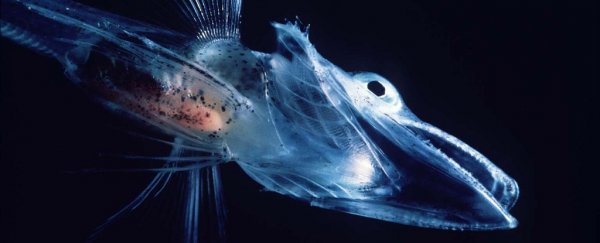Have you ever wondered how fish manage to survive temperatures below freezing in Antarctic waters? (You are now.) It's a pretty neat question - and now, thanks to genome analysis, we actually have an answer.
For one fish, that is. And boy is it an odd one. It's called the Antarctic blackfin icefish (Chaenocephalus aceratus), known for several peculiarities - and one in particular.
This fish and its Channichthyidae cousins, native to the Antarctic seas, don't have any functioning red blood cells, which are normally responsible for transporting oxygen around the body. They are the only vertebrates known to possess this trait.
So there they are, swimming around in the black and gelid water in temperatures below 0 degrees Celsius (32 degrees Fahrenheit), with no functional haemoglobin - the protein found in red blood cells.
To compensate, they evolved a huge heart, enhanced vascular systems, and started producing antifreeze glycoproteins to lower the internal freezing temperature.
Happy #Halloween! This ghoulish Antarctic icefish doesn’t have any red blood cells but has antifreeze in its plasma! pic.twitter.com/L7TmXMi3uu
— British Antarctic Survey 🐧 (@BAS_News) October 31, 2014
Now, scientists have analysed the fish's genome to find out why these extreme adaptations evolved.
Researchers from the Korea Polar Research Institute found that the icefish's suborder, Notothenioidei, diverged from the lineage that produced the stickleback some 77 million years ago. Using comparative genomics, they were able to quantify the changes.
By the time the Antarctic had reached -1.9 degrees Celsius (25.58 degrees Fahrenheit), around 10-14 million years ago, notothenioids were starting to diversify, producing cold-tolerant adaptations.
"Our results show that genes involved in protection from ice damage, including genes encoding antifreeze glycoprotein and zona pellucida [egg] proteins, are highly expanded in the icefish genome," the researchers wrote in their paper.
"Furthermore, genes that encode enzymes that help to control cellular redox state .. are expanded, probably as evolutionary adaptations to the relatively high concentration of oxygen dissolved in cold Antarctic waters."
The antifreeze proteins protected the organisms, and the ice-resistant egg proteins kept their unhatched young safe.
The analysis also revealed that some of the circadian regulation genes had been deleted in the icefish. This suggests that the day-night cycle in Antarctica - where the Sun never sets in summer, nor rises in winter - limits the usefulness of circadian regulation.
The selection pressures to keep these circadian rhythm genes probably eased since the fish weren't using them, allowing the genes to be degraded through mutations over time.
This will need further research to verify - to see if the icefish actually lack this day-night cycle behaviour, possibly including comparison with creatures that live in the abyssopelagic, the zone of the ocean that's so deep sunlight can't penetrate.
Any discoveries about these enigmatic icefish are bound to increase our understanding of how life can adapt itself even to the most severe and inhospitable environments.
"The blackfin icefish genome provides an elegant natural model to facilitate exploration of genomic contributions to a wide range of evolutionary, ecological, metabolic, developmental and biochemical features of Antarctic fish as they adapted to the extreme low temperatures, high oxygen levels and greatly fluctuating day lengths of Antarctica," the researchers wrote in their paper.
"The availability of the icefish genome sequence will accelerate our understanding of adaptation to extreme Antarctic environments."
The paper has been published in the journal Nature Ecology & Evolution.
